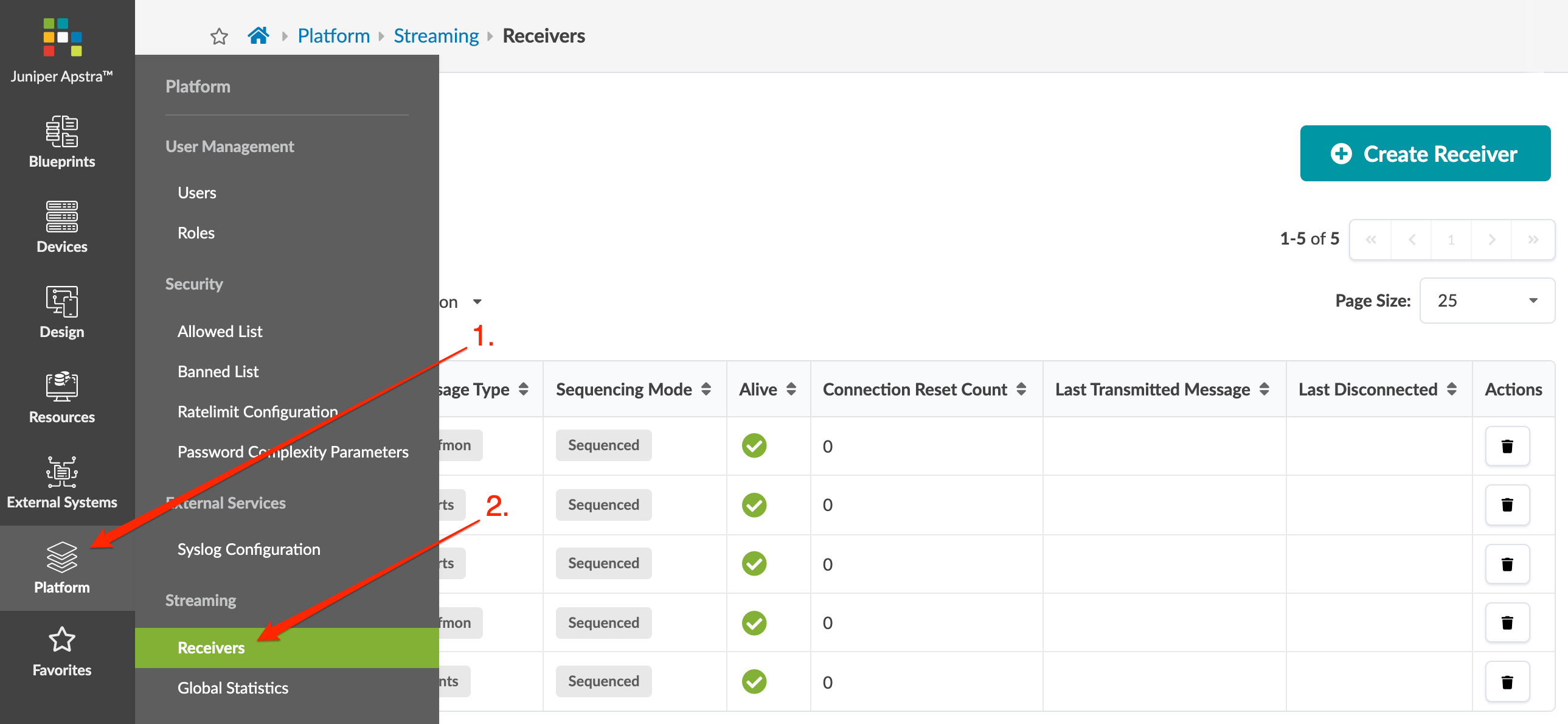Receivers (Platform)
Streaming Receivers Overview
You can configure the Apstra server to stream alerts, events and perfmon, or any combination thereof. Each data type is sent to a streaming receiver over its own TCP socket. Even if all three data types are configured for the same streaming receiver, three (3) connections are created between the Apstra server and the streaming receiver. This also allows for all three types to be sent to three different streaming receivers.
Receivers include the following details:
- Hostname - Hostname
- Port - default: 4444
- Message Type - alerts, events, perfmon
- Sequencing Mode - unsequenced, sequenced
From the left navigation menu, navigate to Platform > Streaming >
Receivers to go to receivers. You can create and delete receivers.

Create Receiver
- From the left navigation menu of the Apstra GUI, navigate to Platform > Streaming > Receivers and click Create Receiver.
- Enter/select required values.
- Click Create to create the receiver and return to the table view.
Delete Receiver
- From the left navigation menu of the Apstra GUI, navigate to Platform > Streaming > Receivers and click the delete button for the receiver to delete.
- Click Delete to delete the receiver from the system and return to the table view.
Configure Receivers Using Telegraf Plugin
You can use the Apstra Telegraf input plugin to receive streaming telemetery from Apstra. Telegraf is an agent for collecting, processing, aggregating, and writing metrics. This is the component of AOSOM-Streaming that handles the reception of the protobuf messages from the Apstra environment. For more information, see the AOSOM Streaming Guide. The Telegraf platform consists of input and output plugins that you can choose from for aggregating and storing metrics to different backend databases. The Apstra input plugin for Telegraf deserializes the protobuf stream and creates metrics that can then be sent to a particular backend database, such as Prometheus, InfluxDB, or Elasticsearch.
The configuration described here assumes you are using the Apstra Telegraf input plugin. You can configure streaming receivers in Apstra with the Telegraf plugin by providing it Apstra credentials. We recommend that you use a separate Apstra account with only the streaming credentials. If you configure through the GUI, then there is no need to supply credentials in the Telegraf config file.
The easiest way to run the Telegraf receiver is in a docker container. The
docker-compose.yml snippet below shows the configuration for
the Telegraf container. This pulls the latest Apstra supported Telegraf container
from Docker Hub.
# Telegraf container config
telegraf-prom:
image: apstra/telegraf:latest
command: telegraf
volumes:
- ./config/telegraf-prom.toml:/etc/telegraf/telegraf.conf
ports:
- '9999:9999'The Telegraf configuration file - ./config/telegraf-prom.toml - is
mapped to /etc/telegraf/telegraf.conf on the container. It includes
the following parameters:
- address - specifies the IP address of the streaming receiver
- port - specifies the port that the streaming receiver will be listening on
- streaming_type - specifies the type of data to be streamed from Apstra to this receiver
The remaining parameters are only necessary if you want the Apstra Telegraf plugin to configure the streaming receivers in Apstra via the API.
- aos_server - specifies the IP address of the Apstra server
- aos_port - should always be 443
- aos_login - Apstrs username
- aos_password - Apstra password
The input and output plugin configurations are shown in the snippet below. The output plugin is configured for the Prometheus client and listens on port 9126. The input plugin is configured for Apstra.
# Configuration for Prometheus server to expose metrics [[outputs.prometheus_client]] listen = ":9126" expiration_interval = "0" [[inputs.aos]] address = "10.1.1.200" port = 9999 streaming_type = [ "perfmon", "alerts", "events" ] aos_server = "$AOS_SERVER" aos_port = $AOS_PORT aos_login = "$AOS_LOGIN" aos_password = "$AOS_PASSWORD"
